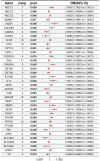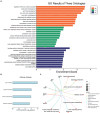Renshen Yangrong decoction for secondary malaise and fatigue: network pharmacology and Mendelian randomization study
- PMID: 38966421
- PMCID: PMC11222649
- DOI: 10.3389/fnut.2024.1404123
Renshen Yangrong decoction for secondary malaise and fatigue: network pharmacology and Mendelian randomization study
Abstract
Background: Renshen Yangrong decoction (RSYRD) has been shown therapeutic effects on secondary malaise and fatigue (SMF). However, to date, its bioactive ingredients and potential targets remain unclear.
Purpose: The purpose of this study is to assess the potential ingredients and targets of RSYRD on SMF through a comprehensive strategy integrating network pharmacology, Mendelian randomization as well as molecular docking verification.
Methods: Search for potential active ingredients and corresponding protein targets of RSYRD on TCMSP and BATMAN-TCM for network pharmacology analysis. Mendelian randomization (MR) was performed to find therapeutic targets for SMF. The eQTLGen Consortium (sample sizes: 31,684) provided data on cis-expression quantitative trait loci (cis-eQTL, exposure). The summary data on SMF (outcome) from genome-wide association studies (GWAS) were gathered from the MRC-IEU Consortium (sample sizes: 463,010). We built a target interaction network between the probable active ingredient targets of RSYRD and the therapeutic targets of SMF. We next used drug prediction and molecular docking to confirm the therapeutic value of the therapeutic targets.
Results: In RSYRD, network pharmacology investigations revealed 193 possible active compounds and 234 associated protein targets. The genetically predicted amounts of 176 proteins were related to SMF risk in the MR analysis. Thirty-seven overlapping targets for RSYRD in treating SMF, among which six (NOS3, GAA, IMPA1, P4HTM, RB1, and SLC16A1) were prioritized with the most convincing evidence. Finally, the 14 active ingredients of RSYRD were identified as potential drug molecules. The strong affinity between active components and putative protein targets was established by molecular docking.
Conclusion: This study revealed several active components and possible RSYRD protein targets for the therapy of SMF and provided novel insights into the feasibility of using Mendelian randomization for causal inference between Chinese medical formula and disease.
Keywords: Mendelian randomization; Renshen Yangrong decoction; molecular docking; network pharmacology; secondary malaise and fatigue.
Copyright © 2024 Wang, Zhu, Cui, Guo, Wu, Li and Wang.
Conflict of interest statement
The authors declare that the research was conducted in the absence of any commercial or financial relationships that could be construed as a potential conflict of interest.
Figures











Similar articles
-
Network pharmacology-based and experimental identification of the effects of Renshen Yangrong decoction on myocardial infarction.Front Pharmacol. 2022 Oct 25;13:1010036. doi: 10.3389/fphar.2022.1010036. eCollection 2022. Front Pharmacol. 2022. PMID: 36386237 Free PMC article.
-
Exploring potential drug targets for SLE through Mendelian randomization and network pharmacology.PLoS One. 2025 Jan 17;20(1):e0316481. doi: 10.1371/journal.pone.0316481. eCollection 2025. PLoS One. 2025. PMID: 39823480 Free PMC article.
-
Causal effects of gut microbiota on sepsis and sepsis-related death: insights from genome-wide Mendelian randomization, single-cell RNA, bulk RNA sequencing, and network pharmacology.J Transl Med. 2024 Jan 2;22(1):10. doi: 10.1186/s12967-023-04835-8. J Transl Med. 2024. PMID: 38167131 Free PMC article.
-
Integrating Network Pharmacology, Bioinformatics, and Mendelian Randomization Analysis to Identify Hub Targets and Mechanisms of Kunkui Baoshen Decoction in Treating Diabetic Kidney Disease.Curr Pharm Des. 2024;30(42):3367-3393. doi: 10.2174/0113816128331463240816145054. Curr Pharm Des. 2024. PMID: 39238373
-
Network pharmacology prediction and molecular docking-based strategy to explore the potential mechanism of Huanglian Jiedu Decoction against sepsis.Comput Biol Med. 2022 May;144:105389. doi: 10.1016/j.compbiomed.2022.105389. Epub 2022 Mar 9. Comput Biol Med. 2022. PMID: 35303581 Review.
References
-
- Latimer KM, Gunther A, Kopec M. Fatigue in adults: evaluation and management. Am Fam Physician. (2023) 108:58–69. PMID: - PubMed
Grants and funding
LinkOut - more resources
Full Text Sources
Miscellaneous

